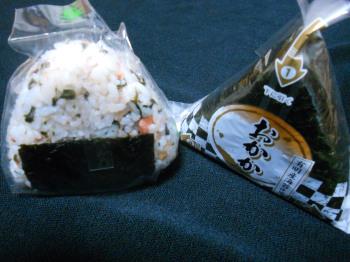
Consider the humble onigiri. Fans of Japanese media, particularly those of anime, are probably familiar with the ubiquitous rice ball. As much as the English dubs of anime try to make onigiri into cookies, popcorn balls, or even onions, we know better! Besides, while I may have seen a cube-shaped watermelon (thanks, Japan!), never once in my life have I set eyes upon a triangular onion. Giant robots aside, anime doesn’t bend the rules of reality that much.

I had heard of rice balls while I was living in the US, but I didn’t know a lot about them, and I certainly had never eaten one. Fortunately for me, onigiri pop up in supermarkets and convenience stores in Japan as much as they do in Japanese media. Even though I couldn’t understand the Japanese at the time, I chose a promising-looking 100 yen (1.00 USD) rice ball from the onigiri shelf at 7-11 and wasted no time in eating it. Unexpected seaweed filling is not ideal for an American unused to such food. Still, I found that I liked it and was excited to discover more.
I’m definitely not an onigiri expert, but I’d like to share a few things I’ve learned about rice balls.
- Onigiri, the Japanese word for rice ball, can be broken up in this way: “O” is the Japanese honorific put in front of many words to make them sound more “polite,” and “nigiri” means “to shape.” This refers to how onigiri are created – by molding the rice with your hands.
- “Onigiri” is the most common way to refer to rice balls in Japan, but sometimes onigiri are called “omusubi.”
- Onigiri come in a variety of shapes and sizes. However, the most common rice ball is one that is triangular and just the right size to fit in your hand.
- Since onigiri are so portable, they are often used for obento (lunch boxes), hiking, and food-on-the-go.
- Many people make rice balls at home, but they are also widely available in grocery stores and convenience stores around Japan. Rice balls can be eaten cold, but they taste better warm, and convenience stores will microwave them for you.
- On the outside, onigiri may be covered in nori (dried seaweed), have a strip of seaweed down the middle, or have nothing on the outside at all.
- Some of the most popular fillings are tuna mayonnaise, salmon, and umeboshi (pickled plum). My personal favorite is tarako, which is cod roe (fish eggs).
That’s all the onigiri knowledge I could squeeze out of my brain at the moment…I’m feeling hungry now.
Have you ever eaten a rice ball? What kind would you like to try? Feel free to share!

